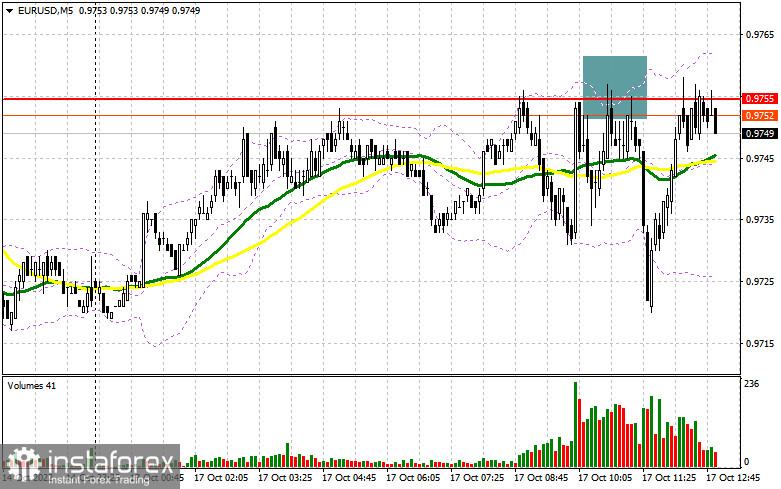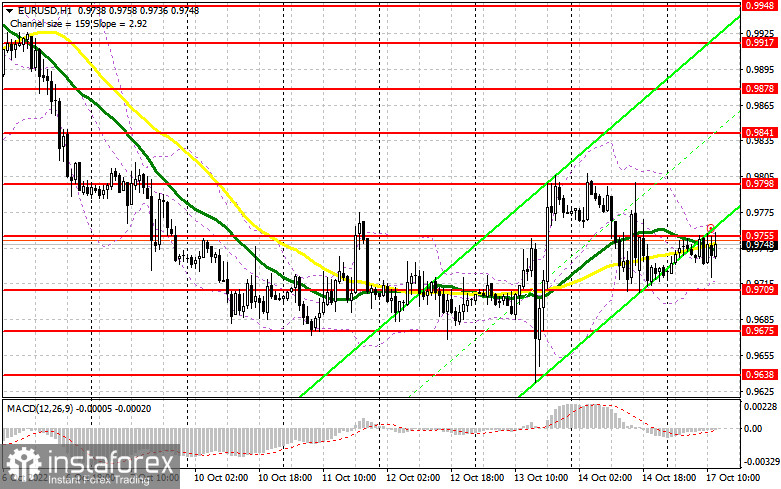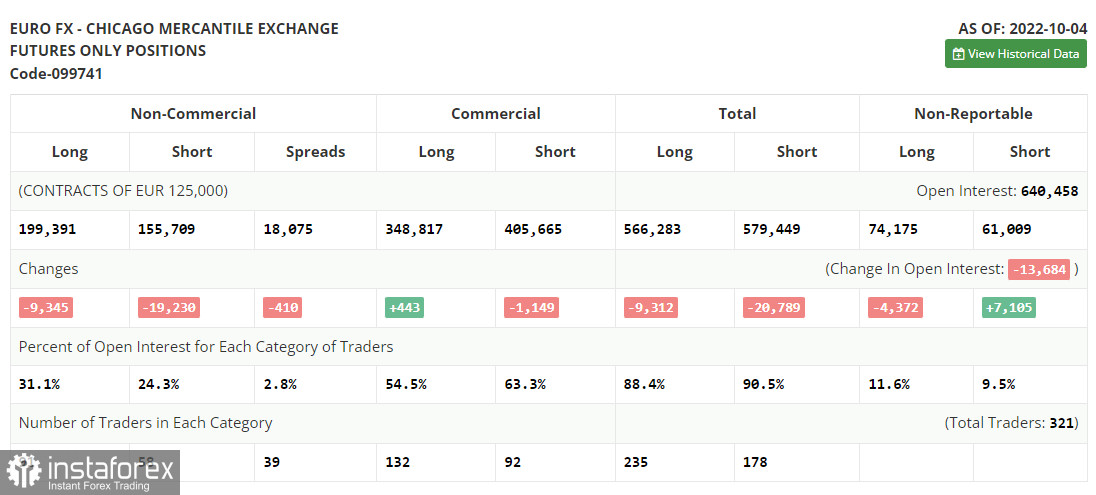In the morning article, I turned your attention to the level of 0.9755 and recommended making decisions with this level in focus. Now, let's look at the 5-minute chart and try to figure out what actually happened. This level was crucial for bulls and bears. Bulls even tried to push the pair above this level, which led to a sell signal. The pair dropped by more than 30 pips. For the second half of the day, the technical outlook has not changed, as well as the trading strategy.

Conditions for opening long positions on EUR/USD:
Today, the US is going to unveil a couple of economic reports, namely the NY Empire State Manufacturing Index and the US federal spending report. However, traders are likely to ignore them. Therefore, they will hardly trigger volatility. Given the macro stats published last week, these reports will barely surprise investors. If pressure on the euro returns and the pair declines, a false breakout of 0.9709, the lower border of the current sideways channel, will give an excellent buy signal with the prospect of a further rise to 0.9755. The bulls could take the upper hand only after a breakout of 0.9755. Their first attempt turned out to be unsuccessful in the morning. Only a downward test of this level will force bears to close Stop Loss orders and generate an additional buy signal with the possibility of an increase to the upper border of the side channel located at 0.9798. A trend reversal may take place if the price consolidates above this level. It will undermine the bear market that has been unfolding since October 4. If the pair climbs above 0.9798, it could approach 0.9841 where I recommend locking in profits. If EUR/USD declines during the US session and buyers show no activity at 0.9709, the pressure on the euro will escalate. The pair could slide deeper into the sideways channel, declining to 0.9675. Nevertheless, it does not mean that bears could take control. It is better to open long positions if a false breakout of 0.9675 occurs. You can buy EUR/USD immediately at a bounce from 0.9638 or 0.9592, keeping in mind an upward intraday correction of 30-35 pips.
Conditions for opening short positions on EUR/USD:
The bears need to defend the middle of the sideways channel located at 0.9755. They managed to do so in the first half of the day. Although the pair decreased, it did not reach 0.9709, the lower border of the sideways channel. It would be appropriate to open short positions after a false breakout of 0.9755, similar to the one that occurred in the morning. However, this will be the third test of the level in a row. Besides, there are hardly many traders who want to sell the pair at this level. The pair could return to 0.9709, the lower border of the sideways channel. At this level, sellers may face problems. A drop below this level as well as an upward test will give a sell signal. Bulls will have to close their Stop Loss orders. The price may fall to 0.9675. A more distant target will be 0.9638 where large traders open long positions last week following the release of US inflation data. I recommend locking in profits there. If EUR/USD rises during the US session and bears show no energy at 0.9755, demand for the pair may increase. If so, a strong upward correction is likely to take place. In this case, it is recommended to cancel short positions until a false breakout of 0.9798, similar to the one I have mentioned above, takes place. You can sell EUR/USD immediately at a bounce from 0.9841 or 0.9878, keeping in mind a downward intraday correction of 30-35 pips.

COT report
The COT report (Commitment of Traders) for October 4 logged a sharp drop in both short and long positions. Many large investors prefer a wait-and-see approach now, especially given mounting geopolitical tensions. It is facilitating demand for the US dollar as a safe-haven currency. Analysts reckon that the euro may soon plunge to new lows versus the greenback amid the latest US Nonfarm Payrolls report and the inflation figures for September. In the near future, risky assets may face strong bearish pressure, dropping to yearly lows. The COT report revealed that the number of long non-commercial positions decreased by 9,345 to 199,391, while the number of short non-commercial positions slid by 19,230 to 155,709. At the end of the week, the total non-commercial net position remained positive and amounted to 43,682 against 33,797. It appears investors are taking advantage of the moment, buying the euro below the parity level. They are also increasing long positions, betting on the improvement in the energy crisis and a long-term rally of the euro. The weekly closing price advanced to 1.0053 against 0.9657.

Signals of technical indicators
Moving averages
EUR/USD is trading near 30- and 50-period moving averages, indicating market uncertainty.
Remark. The author is analyzing the period and prices of moving averages on the 1-hour chart. So, it differs from the common definition of classic daily moving averages on the daily chart.
Bollinger Bands
If EUR/USD climbs, the indicator's upper border at 0.9770 will act as resistance.
Definitions of technical indicators
- Moving average recognizes an ongoing trend through leveling out volatility and market noise. A 50-period moving average is plotted in yellow on the chart.
- Moving average identifies an ongoing trend through leveling out volatility and market noise. A 30-period moving average is displayed as the green line.
- MACD indicator represents a relationship between two moving averages that is a ratio of Moving Average Convergence/Divergence. The MACD is calculated by subtracting the 26-period Exponential Moving Average (EMA) from the 12-period EMA. A 9-day EMA of the MACD called the "signal line".
- Bollinger Bands is a momentum indicator. The upper and lower bands are typically 2 standard deviations +/- from a 20-day simple moving average.
- Non-commercial traders - speculators such as retail traders, hedge funds, and large institutions who use the futures market for speculative purposes and meet certain requirements.
- Non-commercial long positions represent the total long open position of non-commercial traders.
- Non-commercial short positions represent the total short open position of non-commercial traders.
- The overall non-commercial net position balance is the difference between the short and long positions of non-commercial traders.





















